These are the two line of assembler code.
0x0000000000400e8e <+34>: mov -0x8(%rbx),%eax
0x0000000000400e91 <+37>: add -0x4(%rbx),%eax
The following is the whole assembler code and the printed register, where the arrow on the left indicates the location that the code is currently stepped on:
Dump of assembler code for function phase_2:
0x0000000000400e6c <+0>: push %rbp
0x0000000000400e6d <+1>: push %rbx
0x0000000000400e6e <+2>: sub $0x28,%rsp
0x0000000000400e72 <+6>: mov %rsp,%rsi
0x0000000000400e75 <+9>: callq 0x401391 <read_six_numbers>
0x0000000000400e7a <+14>: cmpl $0x0,(%rsp)
0x0000000000400e7e <+18>: jne 0x400e87 <phase_2+27>
0x0000000000400e80 <+20>: cmpl $0x1,0x4(%rsp)
0x0000000000400e85 <+25>: je 0x400ea8 <phase_2+60>
0x0000000000400e87 <+27>: callq 0x40136f <explode_bomb>
0x0000000000400e8c <+32>: jmp 0x400ea8 <phase_2+60>
=> 0x0000000000400e8e <+34>: mov -0x8(%rbx),%eax
0x0000000000400e91 <+37>: add -0x4(%rbx),%eax
0x0000000000400e94 <+40>: cmp %eax,(%rbx)
0x0000000000400e96 <+42>: je 0x400e9d <phase_2+49>
0x0000000000400e98 <+44>: callq 0x40136f <explode_bomb>
0x0000000000400e9d <+49>: add $0x4,%rbx
0x0000000000400ea1 <+53>: cmp %rbp,%rbx
0x0000000000400ea4 <+56>: jne 0x400e8e <phase_2+34>
0x0000000000400ea6 <+58>: jmp 0x400eb4 <phase_2+72>
0x0000000000400ea8 <+60>: lea 0x8(%rsp),%rbx
0x0000000000400ead <+65>: lea 0x18(%rsp),%rbp
0x0000000000400eb2 <+70>: jmp 0x400e8e <phase_2+34>
0x0000000000400eb4 <+72>: add $0x28,%rsp
0x0000000000400eb8 <+76>: pop %rbx
0x0000000000400eb9 <+77>: pop %rbp
0x0000000000400eba <+78>: retq
End of assembler dump.
